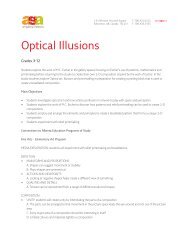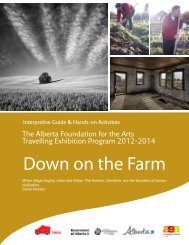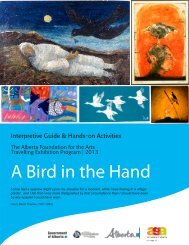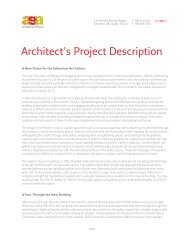Urban Animals - Art Gallery of Alberta
Urban Animals - Art Gallery of Alberta
Urban Animals - Art Gallery of Alberta
You also want an ePaper? Increase the reach of your titles
YUMPU automatically turns print PDFs into web optimized ePapers that Google loves.
The <strong>Alberta</strong> Foundation for the <strong>Art</strong>s Travelling Exhibition Program<br />
The History <strong>of</strong> Abstraction: A Survey con’t<br />
Colour Field Painting<br />
Abstraction in the visual arts has taken<br />
many forms over the 20th century. One <strong>of</strong><br />
these is Colour Field Painting.<br />
Colour Field painting emerged in New York<br />
City during the 1940s and 1950s. Inspired by<br />
European modernism and closely related to<br />
Abstract Expressionism, colour field<br />
painting is characterized primarily by large fields<br />
<strong>of</strong> flat, solid colour spread across or stained into<br />
the canvas creating areas <strong>of</strong> unbroken surface<br />
and a flat picture plane. The movement places<br />
less emphasis on gesture, brushstrokes and<br />
action in favour <strong>of</strong> an overall consistency <strong>of</strong><br />
form and process.<br />
Henri Matisse<br />
View <strong>of</strong> Notre Dame, 1914<br />
Oil on canvas<br />
Museum <strong>of</strong> Modern <strong>Art</strong>, New York<br />
The use <strong>of</strong> large opened fields <strong>of</strong> expressive colour applied in generous painterly portions,<br />
accompanied by loose drawing, was first seen in the early 20th century works <strong>of</strong> Henri Matisse<br />
and Joan Miró. These artists, along with Pablo Picasso, Paul Klee, Wassily Kandinsky and Piet<br />
Mondrian directly influenced the Abstract Expressionists, the Colour Field painters and the<br />
Lyrical Abstractionists. During the late 1950s and 1960s Colour Field painters emerged in<br />
Great Britain, Canada, Washington, D.C. and the West Coast <strong>of</strong> the United States. Using<br />
formats <strong>of</strong> stripes, targets, simple geometric patterns and references to landscape<br />
imagery and to nature these artists began to break away stylistically from abstract<br />
expressionism; experimenting with new ways <strong>of</strong> making pictures and new ways <strong>of</strong><br />
handling paint and colour. The artists associated with the Colour Field movement moved<br />
away from the violence and anxiety <strong>of</strong> Action Painting toward a new and ‘calmer’<br />
language <strong>of</strong> colour.<br />
An important distinction that made colour field painting different from abstract<br />
expressionism was the paint handling. Colour Field painters revolutionized the way paint<br />
could be effectively applied as they sought to rid art <strong>of</strong> superfluous rhetoric. In this aim<br />
they used greatly reduced formats with drawing essentially simplified to repetitive and<br />
regulated systems, basic references to nature, and a highly articulated and<br />
psychological use <strong>of</strong> colour. In general these painters eliminated overt recognizable imagery<br />
and sought to present each painting as one unified, cohesive, monolithic image <strong>of</strong>ten with series<br />
<strong>of</strong> related types. Unlike the emotional energy and gestural surface marks and paint handling <strong>of</strong><br />
abstract expressionists, colour field painters sought to efface individual marks in favour <strong>of</strong> large,<br />
flat, stained and soaked areas <strong>of</strong> colour.<br />
AFA Travelling Exhibition Program, Edmonton, AB. Ph: 780.428.3830 Fax: 780.421.0479<br />
youraga.ca

















